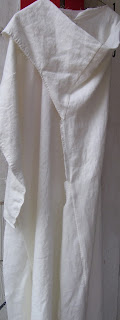I have called this garment an under-dress or under-tunic but it is also referred to as a smock. Generally, this smock is not seen except perhaps a small amount at the wrists, neckline and hemline. The smock is un-dyed linen which would be off white or tan colored or is sun bleached to white. The cutting pattern may have under arm gussets and side gores. (Earlier Anglo-Saxon finds and later period finds such as in Greenland have evidence of both.) Fabric of this era was hand woven and the looms discovered would not have been able to weave cloth too wide. Since the fabric was narrow, the gores and gussets could add extra fullness where needed such as for arm movement or leg room for walking, warmth, and bending over. The weaving could have been fine and the threads close together but most smocks were not as fine of quality as outer layers as that would be a wasteful use of higher quality of fabric. I suggest they were bleached because they would have gotten pretty dingy and stained in wearing. There was probably decorative seam and hem stitching for strength and support but one would not have wasted precious time on embellishing a garment that wouldn’t be seen such as the side seams or gores. I also imagine this piece of clothing would have been patched and repaired extensively as it would not be visible underneath and decorative stitching may have been used to pretty it up for hand me downs.
There is some discussion that the smocks were pleated based on the wrinkled nature of the finds and on some of the carved woman figures found. Linen wrinkles very easy in wearing and may have also been slightly wrinkled while lying in the graves, wet bogs and harbors all those years. There is no way to say for sure except the figures in some artwork appear to be wearing pleated under garments and trains and wrinkled bits of linen have been found in fabrics preserved under metal brooches and pins. There is evidence for ‘slicks’ that would have been used to press linen during construction and perhaps for upkeep. This could indicate that wrinkles would not be created by choice?
This layer could also be considered a slip and may have been the only underwear a woman in this era would have worn. However there is nothing that suggests they did not have other underwear…there is just no evidence for it. (Personally, I would have needed leggings or wraps to keep warm in the cold months.)
My recreation:
I used a medium weight European bleached ivory linen fabric with a thread count of approximately 22 threads per inch. Even though my fabric was wider than would have been available then, I cut the pieces in rectangular shapes and used underarm gussets and gores to create fullness where I needed it. I drafted my pattern pieces based on a cutting layout by…….. I used linen thread to COMPLETELY hand sew the garment and a combination of running and flat felling stitching to make sure the seams were secure and would not fray too easily. Most of the seams have been sewn at least 3 times and 4 where topstitched. I made a neck opening and faced the neck slit with a silk remnant so that the linen wouldn’t rub and irritate my neck and sewed a rolled hem finish on the neckline. I also did rolled hems on the sleeves and main garment hem. I have done some simple topstitching on the seams, hems and neckline. The neck slit will be closed with a small decorative pin.
This smock may be a little fuller than I needed in the body but the sleeves are almost tight in places. The neckline seems to lay well and I like how the sleeves fit at the wrists and basically that is all that will show when wearing the complete outfit. I raised my arms when trying it on and thought, “So that’s what underarm gussets are for!” They worked perfectly to give my arms freedom to move…SUCCESS! I have not enjoyed the feel of this linen as I worked on it. I washed the fabric 3 times and ironed before cutting out but it still felt rough all the while I worked on it. After making sure all seams were enclosed and secure, I washed the garment one more time. The gore seams that overlap are very stiff and thick and I feel like I want to pound on them with a hammer to flatten them…
This smock may be a little fuller than I needed in the body but the sleeves are almost tight in places. The neckline seems to lay well and I like how the sleeves fit at the wrists and basically that is all that will show when wearing the complete outfit. I raised my arms when trying it on and thought, “So that’s what underarm gussets are for!” They worked perfectly to give my arms freedom to move…SUCCESS! I have not enjoyed the feel of this linen as I worked on it. I washed the fabric 3 times and ironed before cutting out but it still felt rough all the while I worked on it. After making sure all seams were enclosed and secure, I washed the garment one more time. The gore seams that overlap are very stiff and thick and I feel like I want to pound on them with a hammer to flatten them…
September 2011
I have resumed working on the white linen under dress next and will get some better photos of it…I hope? My camera is having trouble showing the detail on the white color… My eyes also have trouble seeing the white on white thread…



















































